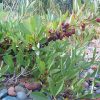Rose Milkweed (Asclepias incarnata)
$4.00
Also called Swamp, Red, or Marsh Milkweed (we like “rose” better!), this species has a lovely vanilla scent and is deer-resistant. It thrives in wet soils but grows in average soils as well. The flowers are a favorite of various butterfly species, including monarchs and swallowtails. It is one of many native milkweed species that monarch butterfly larvae use as a source of food. The milkweed contains a toxic compound that once consumed makes the butterfly unpalatable to predators throughout its lifecycle. Milkweeds like this species also have medicinal applications and have been used in salves and infusions for various applications. However, they should be prepared with caution due to the plants inherent toxicity.
Plants are currently provided in recycled plastic pots donated to our nursery by community members (size varies, especially at the farmstand!)
Out of stock
Description
Why are We Planting This?
Ecological Gifts
Pollinator favorite and a host plant for the monarch butterfly.
Edible Gifts
Most parts of the plant are edible (and delicious!) when properly prepared. The stalk can be used as an asparagus substitute, young shoots and seed pods can also be eaten. The flowers can be cooked into a syrup. See more below.
Medicinal Gifts
The plant has a rich medicinal history as well. See more below.
Other Gifts
The soft fluff in the seedpods has buoyant properties and was actually used to stuff life jackets during WWII. It can also be used to stuff other materials like pillows or can be spun into yarn with other fibers or used as candle wicks. Twine can also be made with fibers from the bark. See more below.
Read more about the ethnobotany of this milkweed and its history of medicinal uses at the fully-referenced Plants for a Future and the Native American Ethnobotany Database.
Additional information
| Special Features | Host Plants, Medicinal, Pollinator Favorites |
|---|---|
| Sun | Full, Partial |
| Soil | Average, Wet |
| Height | 3'-4' |
| Bloom Color | Pink |
| Bloom Time | August, July |
| Native Plant Category | Wildflowers |
| Type of Plant | Native to Michigan |


